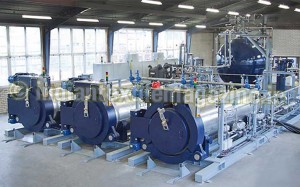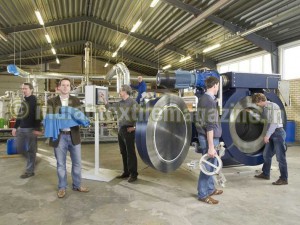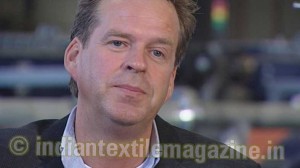Partners Huntsman to develop new products
 Innovative dyes and process technology from Huntsman Textile Effects and DyeCoo help eliminate the use of water in the textile dyeing process. These two industry leaders joined forces in October 2012 to develop and grow the supercritical CO2 (scCO2) textile processing technology. The collaboration is set to create more sustainable products which will benefit the industry as a whole.
Innovative dyes and process technology from Huntsman Textile Effects and DyeCoo help eliminate the use of water in the textile dyeing process. These two industry leaders joined forces in October 2012 to develop and grow the supercritical CO2 (scCO2) textile processing technology. The collaboration is set to create more sustainable products which will benefit the industry as a whole.
By using carbondioxide as the application medium, DyeCoo’s innovative technology completely eliminates the use of water in the textile dyeing process. Huntsman Textile Effects is working with DyeCoo to develop and deliver innovative dye and chemical products to support the waterless dyeing process and to obtain the high level of color fastness and performance that consumers demand.
The Dutch-based DyeCoo, founded in March 2008, is the world’s first supplier of industrial CO2 dyeing equipment and a leading innovator in CO2 dyeing technology and processes. It enabled the textile industry to have environmentally sustainable operations by reducing the amount of water and energy consumed during the dyeing process and lowering the amount of CO2 emitted and waste generated.
DyeCoo uses scCO2 gas rather than water to infuse fabric with color. Special temperature-controlled pressure chambers force the carbondioxide to act as a fluid similar to water (the supercritical fluid CO2) which causes the polymer fiber to swell, allowing the dispersed dye to easily diffuse within the polymer, penetrating the fibers, and carrying the dyes into the fabric and dyeing it.
DyeCoo is believed to be the first company to successfully apply the scCO2 process to commercial dyeing of polyester fabric – the most commonly used fabric in the world – and research is already under way to apply the technology to other natural and synthetic fabrics.
High water consumption
With the exception of agriculture, the textile industry is the heaviest industrial consumer of water. By 2030, it is estimated that the world demand for fresh water will increase by 40 per cent with the growing population, and by 2050, an estimated billion-plus people will also lack the water they need for daily living, such as drinking, cooking and bathing.
In recent years, there has been increased pressure placed on the textile industry by governments, NGOs and consumers to do a better job protecting the environment and to take a more proactive approach in reducing the industry’s environmental footprint. The intense scrutiny is not likely to abate soon. In fact, the industry will likely see tighter regulation as governments step up efforts through new legislation to improve oversight and reduce water pollution by the textile industry around the world.
The textile industry has to necessarily take responsibility and adopt sustainable business practices to truly reduce the environmental impact. For many years, it has tried to identify new ways to reduce water consumption, such as lowering the liquor ratio or using textile dyes that require less water in the dyeing process.
The solution
 DyeCoo has developed what is believed to be the first commercial dyeing machine to use scCO2 as a replacement for water. Supercritical fluids such as CO2 are highly compressed gases with liquid and gas properties of both a liquid and gas. This means that scCO2 may act as both a solvent and a solute as they have higher diffusion coefficients and lower viscosities than liquids. With such properties, they have minimal surface tension which allows for better penetration into materials.
DyeCoo has developed what is believed to be the first commercial dyeing machine to use scCO2 as a replacement for water. Supercritical fluids such as CO2 are highly compressed gases with liquid and gas properties of both a liquid and gas. This means that scCO2 may act as both a solvent and a solute as they have higher diffusion coefficients and lower viscosities than liquids. With such properties, they have minimal surface tension which allows for better penetration into materials.
When CO2 is heated above 31oC and pressurized above 74 bar, it enters a physical state called ‘supercritical’ which is an expanded liquid akin to a heavily compressed gas. One characteristic of this state is its high density which enables the effective dissolution of compounds.
During the dyeing process, scCO2 is heated to 120oC and pressurized to 250 bar. In its expanded liquid state, the CO2 penetrates textile fibres and acts as a swelling agent during the process, which enhances the diffusion of dyes into fibres. The glass-transition temperature of the fibres is lowered, accelerating the rate the dye penetrates the textile.
To fix the dye onto the fibres, CO2 is loaded with dyestuff that penetrates deep into the pore and capillary structure of fibres, providing effective coloration of these hydrophobic materials. After the dyeing process, the remaining CO2 is gasified in order to precipitate the dye, and the clean CO2 can be recycled by pumping it back to the dyeing vessel.
For polyester fibres, dyeing with scCO2 works well as it plasticises the fibres and increases the diffusion coefficients of dyes inside the polyester by one order of magnitude, compared to aqueous dyeing. It eliminates the need to use detergents and salts for dissolving the hydrophobic disperse dyes in the water – a common process for dyeing with polyester fibres.
Huntsman Textile Effects is working with DyeCoo to develop dyes and chemicals that are soluble in CO2 and deliver the range of shades and fastness required by customers.
Huntsman Textile Effects developed and launched a range of dyes, namely, Uvitex SC-PN, Uvitex SC-PB and Uvitex SC-PR, to allow the first processing within scC02 which delivers brighter white shades and makes colors more vibrant. As the scC02 process does give a dryer handle then conventional processing, Ultraphil SC-MC was also introduced to improve the moisture management of the fabrics as required by the major brands. Huntsman Textile Effects will continue to invest in new innovations in the area of scCO2 processing to meet the industry needs.
Materials made of polyester and their blends are often exposed to severe conditions, particularly on whites with yellowing and fading as a consequence. Whether for home textiles such as curtains or sportswear apparel, UVITEX sets new standards in achieving high white effects of bluish cast on PES with high light fastness. It performs at levels of excellence that outmatch conventional PES whiteners. Full white effects can be achieved on polyester fibres which meet the high industry specifications for light fastness in both exhaust and pad-bake processes, with fixation achieved already at low temperatures.
Technology hailed worldwide
Sustainability is important, and the major brands in the industry see waterless dyeing and processing as a major step forward in textile processing. DyeCoo’s waterless dyeing technology has been welcomed by major brands around the world.
In February 2012, Nike announced a strategic partnership with DyeCoo. Eric Sprunk, Nike’s Vice President of Merchandising and Product, explained: “Waterless dyeing is a significant step in our journey to serve both the athlete and the planet, and this partnership reinforces Nike’s long-term strategy and deep commitment to innovation and sustainability. We believe this technology has the potential to revolutionize textile manufacturing, and we want to collaborate with progressive dye houses, textile manufacturers and consumer apparel brands to scale this technology and push it throughout the industry.”
DyeCoo’s first production machine was installed at Thailand’s Tong Siang Co. Ltd., part of the Yeh Group, in 2007. In August 2012, sportswear giant Adidas started using the DryDye technology from the Yeh Group, removing water from the dyeing process completely and using 50 per cent fewer chemicals and 50 per cent less energy than the traditional fabric dyeing process. The company has applied this technology in selected men’s, women’s and kids’ ranges in its Fall/Winter 2012 season, with over 50,000 T-shirts produced using the innovative technology.
In April 2013, IKEA GreenTech, an IKEA Group venture capital company, took a stake in DyeCoo as part of its commitment to make its products, operations and supply chain more sustainable. “DyeCoo’s waterless dyeing technology is a truly innovative system that could bring real environmental and costs benefits for the textile industry by reducing water and chemical use. Through the partnership, IKEA will help to speed up the development and availability of the technology,” says Christian Ehrenborg, Managing Director, IKEA GreenTech.
 “The roll-out of the new revolutionary technology in the textile industry cannot be done without the right partners. The first new products introduced with Huntsman Textile Effects will be in the areas of finishing products and fluorescent brightners. The track record of Huntsman regarding innovation and sustainability makes them a preferred partner for us.”
“The roll-out of the new revolutionary technology in the textile industry cannot be done without the right partners. The first new products introduced with Huntsman Textile Effects will be in the areas of finishing products and fluorescent brightners. The track record of Huntsman regarding innovation and sustainability makes them a preferred partner for us.”
– Reinier Mommaal, CEO and Co-Founder of DyeCoo Textile Systems